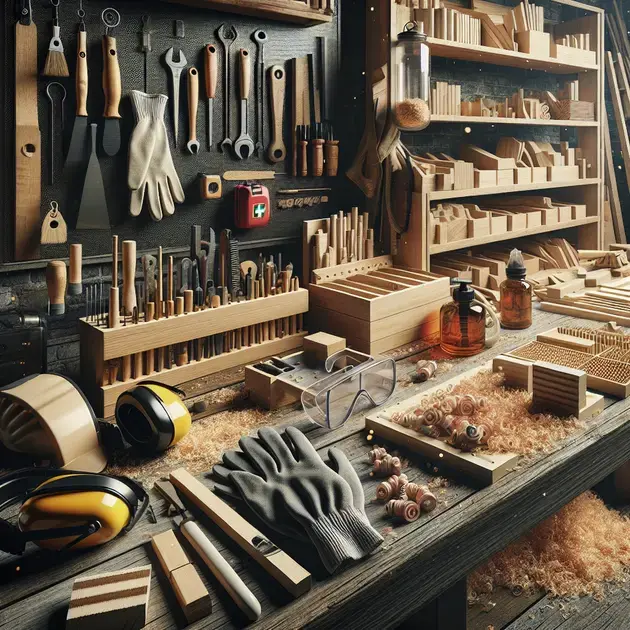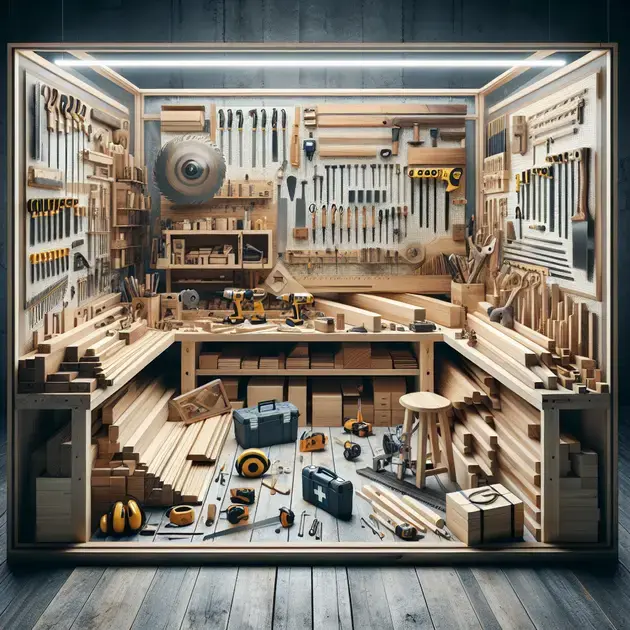When it comes to setting up a functional workshop for your carpentry projects, having the right tools is essential. The Essential Carpentry Tools for Your Workshop can make a significant difference in the quality of your work and the efficiency of your projects.
From traditional hand tools like hammers and chisels to power tools such as drills and saws, equipping your workshop with the right tools is crucial for any carpenter. In this guide, we will explore the must-have tools that every carpentry workshop should have to ensure successful project completion.

Top Must-Have Carpentry Tools
When it comes to carpentry projects, having the right tools is essential for achieving great results. Here are some of the top must-have carpentry tools that every carpenter should have in their arsenal:
1. Tape Measure
A tape measure is a fundamental tool for any carpentry project as it helps you accurately measure and mark materials. The Stanley PowerLock Tape Measure is a popular choice among carpenters for its durability and ease of use. You can easily find this tool at your local hardware store or online on websites like Home Depot.
2. Hammer
Another essential hand tool for carpentry projects is a hammer. The Estwing 16 oz. Straight Rip Claw Hammer is a reliable and well-balanced option for driving nails and making adjustments to wood pieces. You can purchase this hammer on Amazon or at your nearest Lowe’s store.
3. Circular Saw
Power tools are also crucial for carpenters, and a circular saw is a versatile option for cutting through various materials. The DEWALT 7-1/4-Inch Circular Saw is a top choice due to its powerful motor and precise cutting abilities. You can find this tool at major retailers like Home Depot or order it online on the DEWALT website.
4. Screwdriver Set
A screwdriver set is a must-have for assembling furniture or tightening screws in carpentry projects. The Craftsman 17-Piece Screwdriver Set offers a variety of sizes and types to suit different needs. You can purchase this set at Sears or online on the Craftsman website.
5. Level
Ensuring your work is level and plumb is essential in carpentry, making a level a vital tool to have. The Stabila Classic Spirit Level is a durable and accurate option for checking horizontal and vertical alignments. You can buy this level at specialty tool stores or order it online from the Stabila website.

Key Carpentry Tools for Efficient Woodworking
Efficient woodworking requires not only skill and creativity but also the right tools to bring your projects to life. From measuring and cutting to joining and finishing, having the key carpentry tools on hand can make a significant difference in the quality and speed of your work. One essential tool is the cordless drill, which offers versatility and convenience for drilling holes and driving screws. Make sure to choose a model with enough power and battery life to handle your projects.
Another indispensable tool for efficient woodworking is the miter saw, perfect for making accurate crosscuts and miter cuts. This tool is essential for framing, molding, and other precision woodworking tasks. Additionally, a reliable random orbital sander can help you achieve smooth and polished surfaces, saving you time and effort compared to manual sanding.
For precise measurements and layouts, a high-quality combination square is a must-have in any carpenter’s toolkit. This versatile tool can be used for checking 90-degree angles, transferring measurements, and setting depths for various woodworking tasks. Lastly, a sturdy workbench with a vise is essential for providing a stable and secure work area for all your woodworking projects.
By investing in these key carpentry tools, you can streamline your workflow, improve the accuracy of your cuts and joints, and ultimately enhance the quality of your woodworking projects. Whether you are a seasoned professional or a beginner enthusiast, having the right tools at your disposal is essential for efficient and successful woodworking.
Organization Tips for Your Carpentry Workshop
A well-organized workshop is not only more efficient but also safer for woodworking projects. Proper organization can save you time searching for tools and materials, reduce clutter, and create a more productive workspace. Start by designating specific areas for different tasks, such as cutting, sanding, and assembly, to streamline your workflow.
Invest in storage solutions such as pegboards, shelves, and tool chests to keep your tools and supplies neatly organized and easily accessible. Labeling containers and drawers can also help you quickly find what you need during a project. Consider creating a dedicated workbench area with adequate lighting and power outlets for optimal comfort and functionality.
Implementing a regular cleaning and maintenance routine for your workshop can further enhance its organization and efficiency. Sweep the floors, clear off work surfaces, and put tools back in their designated places after each project. This practice not only keeps your workshop tidy but also prolongs the lifespan of your tools and equipment.
By following these organization tips, you can create a well-structured and efficient carpentry workshop that supports your creativity and productivity. A clean and organized workspace can inspire you to take on new projects, improve the quality of your work, and ensure a safe environment for woodworking activities.
Safety Measures to Implement in Your Carpentry Projects
Prioritizing safety in carpentry projects is essential to prevent accidents and injuries in the workshop. Whether you are a professional woodworker or a hobbyist, incorporating safety measures into your workflow is crucial for protecting yourself and others. One fundamental safety practice is wearing appropriate personal protective equipment (PPE), such as safety glasses, hearing protection, and dust masks, to shield yourself from potential hazards.
When using power tools, always follow the manufacturer’s instructions and guidelines for safe operation. Keep your tools well-maintained and sharp to prevent kickbacks and accidents during cutting and drilling tasks. Additionally, avoid distractions and maintain focus on the task at hand to reduce the risk of errors and injuries.
Implementing proper dust collection systems in your workshop can help minimize respiratory issues and keep the air clean while woodworking. Regularly clean up sawdust and debris to prevent slips, trips, and falls in the workshop. Furthermore, secure your workpieces with clamps or vises to prevent movement and ensure stability during cutting and shaping.
By incorporating these safety measures into your carpentry projects, you can create a secure and healthy environment for woodworking tasks. Prioritizing safety not only protects yourself and those around you but also allows you to focus on your craft with peace of mind and confidence in your abilities.
**
Conclusion
**
Efficient woodworking not only relies on skill and creativity but also on having the right tools at your disposal. Key carpentry tools such as the cordless drill, miter saw, random orbital sander, combination square, and workbench play a crucial role in enhancing the quality and speed of your woodworking projects. By investing in these essential tools, you can streamline your workflow, improve the accuracy of your cuts, and elevate the overall quality of your work, whether you’re a seasoned professional or a beginner enthusiast.
Organizing your carpentry workshop is essential for efficiency and safety. Designating specific areas for different tasks, investing in storage solutions like pegboards and shelves, and maintaining a regular cleaning routine can save you time, reduce clutter, and create a more productive workspace. A well-structured and organized workshop inspires creativity, improves the quality of your work, and ensures a safe environment for woodworking activities.
Safety should always be a top priority in carpentry projects. Wearing personal protective equipment, following safety guidelines for power tools, implementing dust collection systems, and securing workpieces with clamps or vises are fundamental safety measures to prevent accidents and injuries. Prioritizing safety not only protects yourself and others but also allows you to focus on your craft with confidence and peace of mind, creating a secure and healthy environment for woodworking tasks.